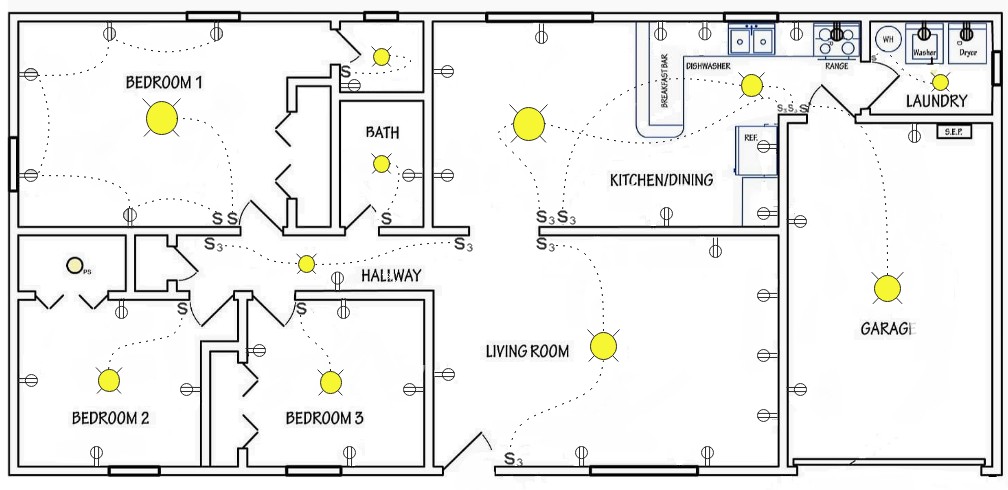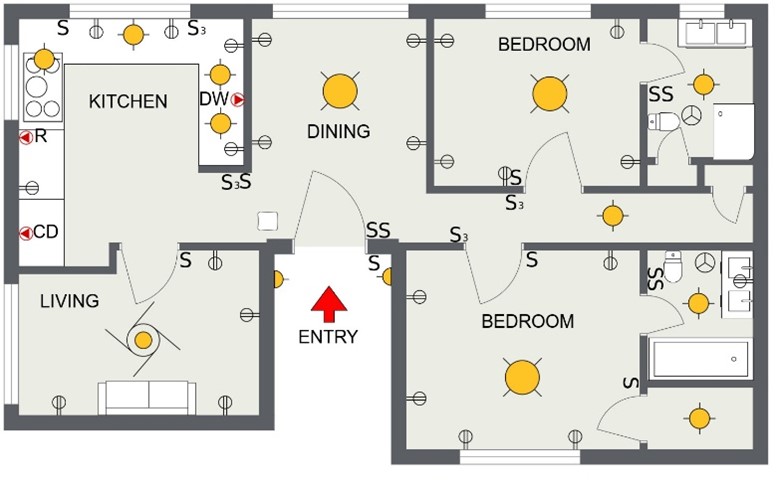How Do You Make An Electrical Wiring Plan?
Making an electrical wiring plan is an important step for any electrical project. It helps to ensure the safety of all involved and that the result will be satisfactory. The process involves laying out the wiring, drawing a map of the circuit, and choosing the correct components and materials. It is important to follow all safety guidelines when wiring an electrical circuit. With some planning and patience, anyone can create a successful electrical wiring plan.
Understanding the Basics of Electrical Wiring
Electrical wiring is an essential component of any home or commercial building. All homeowners and businesses need to understand the basics of electrical wiring to ensure a safe and properly functioning electrical system. Making an electrical wiring plan can help ensure the safety of your property and the people who use it. It is important to have a professional electrician do the work for you, but it is also possible to do it yourself.
When making an electrical wiring plan, you will need to determine the type of wiring you need, the power requirements, and the way the wiring will be laid out. You will also need to consider the types of electrical outlets, switches, and fixtures that you will need. Additionally, you will need to know the type of insulation you will need, as well as the type of cable and conduit you will need to use.
Once you have determined the type of wiring and the way it will be laid out, you will need to draw out the plan. This will involve mapping out the location of the outlets, switches, fixtures, and other items that will be connected to the electrical system. It is important to use the proper symbols for each component to ensure that the plan is accurate and easy to follow.
Lastly, you will need to test your plan to make sure that it is safe and properly functioning. This should be done by a professional electrician and should include testing the continuity of the electrical system, as well as ensuring that all components are installed correctly.
Components of an Electrical Wiring Plan
An electrical wiring plan is a key component in the installation of any electrical system. It is essential to ensure that the wiring is safe and efficient, as well as to avoid costly mistakes. To make an effective wiring plan, one must understand the components that go into the process.
The first step in creating an electrical wiring plan is to determine the necessary components. This includes the type of wiring, the length of the wiring, and the power requirements. This must be done to accurately calculate the size of the electrical box, the type of circuit breakers, and the type of outlets.
The next step is to create a schematic diagram. This is a visual representation of the wiring and connections between components. This diagram should include a legend to indicate the type of wiring, the location of circuit breakers, and the type of outlets.
Once the schematic diagram is complete, a layout of the wiring can be drawn. This should include the location of the outlets, the type of wiring, and the length of the wiring. It is important to make sure that the wiring is laid out logically and that it is properly connected.
Finally, the wiring plan should be tested. This can be done by using a multimeter to check for continuity. It is important to check for any loose connections or other issues that could lead to a dangerous or unreliable electrical system.
Basic Electrical Wiring Safety Guidelines
Electrical wiring is a complex process that requires precision and safety. Before you attempt to wire your home or office, you must first be aware of the basic electrical safety guidelines. Doing so can save you a lot of time, money, and potential injury.
The first step in making an electrical wiring plan is to familiarize yourself with the local electrical code. This code will tell you the minimum requirements for electrical wiring, as well as any safety guidelines that need to be followed.
When making an electrical wiring plan, it’s important to consider the location of the wiring. Make sure that any exposed wiring is placed safely away from high-traffic areas, water sources, and other potential hazards.
It’s also important to be aware of the types of materials needed for wiring. Make sure to use the proper gauge wires, switches, outlets, and other components. This will ensure that the wiring is safe and efficient.
Finally, it’s important to make sure that all wiring is tested and inspected by a qualified electrician. This will ensure that the wiring is installed properly and meets local safety standards.
Creating a Wiring Plan Step-by-Step
Creating a wiring plan for an electrical project can be an intimidating task, especially for those who are new to the field. However, with a little bit of planning and foresight, it can be a straightforward process. To ensure you get the job done right, we’ve created this step-by-step guide to making an electrical wiring plan.
First, you should determine the size of the project and the type of wiring that is necessary. This will help you decide what type of materials and tools you will need. Once you have gathered the necessary materials and tools, you should then create a diagram that outlines the entire project. This diagram should include the location of each circuit, the type of wire to be used, and the location of any outlets that will be installed.
Next, you need to select the appropriate type of wire for the project. There are several different types of wire available, so it’s important to select the one that is best suited for the project. The wire should be rated for the voltage and current that will be running through it.
Once you have selected the wire, you should begin to make the connections. The connections should be made according to local codes and regulations. Make sure that all connections are secure and that the wires are properly insulated.

Testing and Troubleshooting Your Wiring Plan
Creating an electrical wiring plan is a complex task but it can be made easier by following a few simple steps and using the right tools. However, once the wiring plan is completed, it is essential to test and troubleshoot it to make sure that it is working correctly and safely. This step is crucial for the safety of your home and the people living in it.
Testing your wiring plan is a multi-step process that starts with testing the connections and ends with testing the circuits. First, you need to make sure all the connections are secure and tight. You can use a multi-meter to measure the resistance of the connection and ensure that the resistance is within the acceptable limit. You should also check for any loose or broken wires.
Once the connections have been tested, you will need to test the circuits. This can be done using a variety of tools such as a circuit tester, continuity tester, or an ohmmeter. With the help of these tools, you will be able to identify any short circuits and open circuits. This will help you identify any potential issues with the wiring plan.
Finally, you should also perform a voltage drop test. This test will help you identify any potential voltage drops in the wiring plan. By testing and troubleshooting your wiring plan, you can ensure that it is safe and efficient. This will also help you save money and time in the long run.
Common Mistakes to Avoid When Making an Electrical Wiring Plan
Making an electrical wiring plan is a daunting task, but one that is essential for any building or renovation project. While the process may seem intimidating, it’s quite simple once you understand the basics. However, several common mistakes can easily be avoided when creating an electrical wiring plan.
First, it’s important to understand the local building codes and regulations. Make sure to research the local laws and regulations before you begin your project, as failure to comply with codes can lead to fines, delays, and other costly issues. Additionally, it’s important to have the right tools and materials on hand before starting the wiring plan. The wrong type of wire or a poorly designed plan could lead to dangerous situations.
It’s also important to consider the associated costs before beginning your project. A professional electrician will be able to provide valuable insight into the costs and potential savings associated with the project. Additionally, it’s important to consider the complexity of the project. A complex wiring plan may require the services of a professional electrician for proper installation.
Finally, it’s important to ensure that the wiring plan is properly labeled and documented. Proper labeling will make it easier to troubleshoot any issues that may arise in the future. Additionally, it’s important to keep detailed documentation of the wiring plan for future reference.
Hiring a Professional to Create an Electrical Wiring Plan
Creating an electrical wiring plan for a property isn’t a task to be taken lightly. It is a complex and intricate undertaking that requires a lot of knowledge and expertise. That’s why it’s important to hire a professional electrician to help you create an electrical wiring plan.
When you hire an electrician to create an electrical wiring plan for you, they will take into account the specific needs of your property. A professional electrician will understand the layout of the building and the electrical requirements of the area. They will assess the current electrical wiring in the building and then create a plan for how to best connect the wiring and devices.
Professionals will also be able to give you advice on the type of electrical wiring you should use, how much power each device will require, and how to ensure that the wiring is safely installed. They will also be able to ensure that the wiring is designed to meet all safety regulations.
In addition, a professional electrician can help you make sure that the wiring is installed correctly and up to code. They can also help you troubleshoot any problems you may encounter in the future. And when it comes to selecting the right wiring and electrical components for the job, a professional electrician can provide you with the best advice and options.
Advantages of an Electrical Wiring Plan
An electrical wiring plan is an important step in constructing and maintaining a safe and efficient electrical system. Developing an electrical wiring plan can be a complex process and requires a great deal of research and understanding of the relevant electrical codes and regulations. It is important to have a good understanding of the advantages of an electrical wiring plan before beginning the process.
Having an electrical wiring plan in place can help to ensure safety by avoiding mistakes that can lead to fires, electric shocks, or other hazards. It also helps to identify the most efficient path for wiring and can help to reduce costs by avoiding unnecessary wiring. Additionally, an electrical wiring plan can also help to reduce the risk of overloading circuits and other components.
Having an electrical wiring plan can also help to ensure that all components are up to code and are compliant with the electrical safety regulations in place. This is especially true in older homes, where wiring systems may be outdated and not up to current standards. A wiring plan can also help to identify any components that need to be replaced or upgraded, such as older wiring, outlets, and switches.
FAQs About the How Do You Make An Electrical Wiring Plan?
1. What kind of information do I need to create an electrical wiring plan?
You will need to know the power requirements of the equipment you are wiring, the size and type of cable you will use, and the location of the wiring to ensure that it is safe and up to code.
2. How do I know which electrical components to include in my plan?
You should consult the local building code to determine the types of components you need to include in your plan. Additionally, you should discuss the plan with an electrician to ensure that all components are up to code and safe to use.
3. What are the risks involved with electrical wiring?
Electrical wiring can be dangerous if not done correctly. It is important to know the local building codes and consult with an electrician to ensure that your wiring is safe and up to code. Additionally, you should be aware of potential fire hazards and follow all safety protocols when working with electricity.
Conclusion
Creating an electrical wiring plan is an important step when wiring a home or any other building. It is important to understand the basics of electrical wiring before attempting to wire a building. With a good plan and the right materials, it is possible to make an effective wiring plan that will provide a safe and functional electrical system.





